Flexural Behavior of Precast Rectangular Reinforced Concrete Beams with Intermediate Connection Filled with High-Performance Concrete
Abstract
:1. Introduction
2. Experimental Program
2.1. Specimens’ Details
2.2. Material Properties
2.3. Preparation of Tested Specimens
2.4. Test Setup
3. Test Outcome and Discussions
3.1. Failure Patterns
3.2. Cracking and Ultimate Load
3.3. Load-Displacement Curves
3.4. Energy Absorption Capacity and Elastic Stiffness
4. Finite Element Simulation
4.1. Model Built-Up, Interaction Properties, and Boundary Conditions
4.2. Constitutive Modeling of Materials
5. Validation of the FE Model
6. Parametric Study
7. Conclusions
- Test results showed that the rectangular-shaped intermediate connection provided a stiffer and stronger connection compared to the triangular and semi-circular types of intermediate connections. Moreover, by using HPC (UHPECC and ECC), the cracking and ultimate load were found to be higher than in the control beam. The ultimate load of the beams with UHPECC was found to be increased by 29% compared to the control beam.
- The beams filled with UHPECC and ECC resulted in higher energy absorption. The increase in the energy absorptions of U-10, U-12, E-10, and E-12 was calculated as 75%, 184%, 7%, and 42%, respectively. The energy absorption capacity of the tested specimens increased with the increase in the tension bar diameter at the connecting zone.
- The FEM model developed herein was found to accurately predict the performance of the tested specimens, with an average error of maximum 5% observed between the FEM and the test results of the cracking and ultimate load prediction.
- The parametric study shows that increasing the length of the intermediate connection of the semi-circular-shaped connection increased the ultimate load of the beams. However, the rate of the increase was higher for beams filled with RECC; thus, it is recommended that a greater length of intermediate connection should be used to improve the ultimate load of the beams.
Author Contributions
Funding
Data Availability Statement
Conflicts of Interest
References
- Hamoda, A.; Ahmed, M.; Ghalla, M.; Liang, Q.Q.; Abadel, A.A. Flexural performance of precast circular reinforced concrete members with intermediate connection filled with ultra-high-performance-concrete. Case Stud. Constr. Mater. 2023, 19, e02386. [Google Scholar] [CrossRef]
- Zhou, T.; Xu, Y.; Zhou, W.; Hu, Z.; Yu, C.; Liu, Z.; Mahmud, M.T.; Wang, L.; Wan, L. Flexural performance of precast WWCB-filled concrete floor slabs. Case Stud. Constr. Mater. 2024, 20, e02664. [Google Scholar] [CrossRef]
- Kolchunov, V.I.; Fedorova, N.V.; Savin, S.Y.; Kaydas, P.A. Progressive Collapse Behavior of a Precast Reinforced Concrete Frame System with Layered Beams. Buildings 2024, 14, 1776. [Google Scholar] [CrossRef]
- Xu, Q.; Qian, J.; Zhang, Y.; Tang, L.; Man, D.; Zhen, X.; Han, T. Analysis of Progressive Collapse Resistance in Precast Concrete Frame with a Novel Connection Method. Buildings 2024, 14, 1814. [Google Scholar] [CrossRef]
- Xu, C.; Chen, D.; Miramini, S.; Liu, X.; Xu, W.; Zhang, L. Experimental fire performance assessment of a new type of prestressed composite circular precast concrete columns. Eng. Struct. 2023, 278, 115509. [Google Scholar] [CrossRef]
- Beni, M.T.; Madhkhan, M. Experimental study on two innovative ductile moment-resisting precast concrete beam-column connections. Structures 2022, 39, 559–572. [Google Scholar] [CrossRef]
- Ravasini, S.; Vecchi, F.; Belletti, B.; Muttoni, A. Verification of deflections and cracking of RC flat slabs with numerical and analytical approaches. Eng. Struct. 2023, 284, 115926. [Google Scholar] [CrossRef]
- Hamoda, A.; Abdelazeem, F.; Emara, M. Concentric compressive behavior of hybrid concrete–stainless steel double-skin tubular columns incorporating high performance concretes. Thin-Walled Struct. 2021, 159, 107297. [Google Scholar] [CrossRef]
- Cai, M.; Zhu, H.; Chen, Q.; Rabczuk, T.; Zhuang, X. Performance of Engineered Cementitious Composites (ECC) in shield tunnel segmental joints: A comparative study with ordinary reinforced concrete. Case Stud. Constr. Mater. 2024, 20, e03138. [Google Scholar] [CrossRef]
- Li, V.C.; Wu, C.; Wang, S.; Ogawa, A.; Saito, T. Interface tailoring for strain-hardening polyvinyl alcohol-engineered cementitious composite (PVA-ECC). Mater. J. 2002, 99, 463–472. [Google Scholar]
- Naaman, A.E.; Reinhardt, H.-W. Proposed classification of HPFRC composites based on their tensile response. Mater. Struct. 2006, 39, 547–555. [Google Scholar] [CrossRef]
- Li, V.C. On engineered cementitious composites (ECC) a review of the material and its applications. J. Adv. Concr. Technol. 2003, 1, 215–230. [Google Scholar] [CrossRef]
- Esmaeeli, E.; Manning, E.; Barros, J.A. Strain hardening fibre reinforced cement composites for the flexural strengthening of masonry elements of ancient structures. Constr. Build. Mater. 2013, 38, 1010–1021. [Google Scholar] [CrossRef]
- Kyriakides, M.; Billington, S.L. Cyclic response of nonductile reinforced concrete frames with unreinforced masonry infills retrofitted with engineered cementitious composites. J. Struct. Eng. 2014, 140, 04013046. [Google Scholar] [CrossRef]
- Suryanto, B.; Reynaud, R.; Cockburn, B. Sectional analysis of engineered cementitious composite beams. Mag. Concr. Res. 2018, 70, 1135–1148. [Google Scholar] [CrossRef]
- Ayatar, M.E.; Canbay, E.; Binici, B. Strengthening of reinforced concrete frames with engineered cementitious composite panels. Proc. Inst. Civ. Eng.-Struct. Build. 2020, 173, 237–251. [Google Scholar] [CrossRef]
- Billington, S.L.; Yoon, J. Cyclic response of unbonded posttensioned precast columns with ductile fiber-reinforced concrete. J. Bridge Eng. 2004, 9, 353–363. [Google Scholar] [CrossRef]
- Hamoda, A.; Emara, M.; Abdelazeem, F.; Ahmed, M. Experimental and numerical analysis of RC beams strengthened with ECC and stainless steel strips. Mag. Concr. Res. 2022, 75, 251–270. [Google Scholar] [CrossRef]
- Hung, C.-C.; Chen, Y.-S. Innovative ECC jacketing for retrofitting shear-deficient RC members. Constr. Build. Mater. 2016, 111, 408–418. [Google Scholar] [CrossRef]
- Ge, W.-J.; Ashour, A.F.; Ji, X.; Cai, C.; Cao, D.-F. Flexural behavior of ECC-concrete composite beams reinforced with steel bars. Constr. Build. Mater. 2018, 159, 175–188. [Google Scholar] [CrossRef]
- Ding, Y.; Yu, K.-Q.; Yu, J.-t.; Xu, S.-l. Structural behaviors of ultra-high performance engineered cementitious composites (UHP-ECC) beams subjected to bending-experimental study. Constr. Build. Mater. 2018, 177, 102–115. [Google Scholar] [CrossRef]
- Al-Fakih, A.; Mohammed, B.S.; Liew, M. On rubberized engineered cementitious composites (R-ECC): A review of the constituent material. Case Stud. Constr. Mater. 2021, 14, e00536. [Google Scholar] [CrossRef]
- Dadvar, S.A.; Mostofinejad, D.; Bahmani, H. Strengthening of RC columns by ultra-high performance fiber reinforced concrete (UHPFRC) jacketing. Constr. Build. Mater. 2020, 235, 117485. [Google Scholar] [CrossRef]
- Elsayed, M.; Tayeh, B.A.; Abou Elmaaty, M.; Aldahshoory, Y. Behaviour of RC columns strengthened with ultra-high performance fiber reinforced concrete (UHPFRC) under eccentric loading. J. Build. Eng. 2022, 47, 103857. [Google Scholar] [CrossRef]
- Hamoda, A.; Ahmed, M.; Sennah, K. Experimental and numerical investigations of the effectiveness of engineered cementitious composites and stainless steel plates in shear strengthening of reinforced concrete beams. Struct. Concr. 2023, 24, 2778–2799. [Google Scholar] [CrossRef]
- Arulanandam, P.M.; Kanakubo, T.; Singh, S.; Sivasubramanian, M.V. Effect of ECC layer thickness and reinforcement ratio on the load carrying capacity of steel-reinforced composite beams. Struct. Concr. 2023, 24, 2280–2306. [Google Scholar] [CrossRef]
- AbdelAleem, B.H.; Hassan, A.A. Use of rubberized engineered cementitious composite in strengthening flexural concrete beams. Eng. Struct. 2022, 262, 114304. [Google Scholar] [CrossRef]
- Zhu, J.-X.; Weng, K.-F.; Huang, B.-T.; Xu, L.-Y.; Dai, J.-G. Ultra-High-Strength Engineered Cementitious Composites (UHS-ECC) panel reinforced with FRP bar/grid: Development and flexural performance. Eng. Struct. 2024, 302, 117193. [Google Scholar] [CrossRef]
- Hamoda, A.A.; Ahmed, M.; Abadel, A.A.; Ghalla, M.; Patel, V.I.; Liang, Q.Q. Experimental and numerical studies of circular precast concrete slender columns with intermediate connection filled with high-performance concrete. Structures 2023, 57, 105204. [Google Scholar] [CrossRef]
- Carreira, D.J.; Chu, K.-H. Stress-strain relationship for plain concrete in compression. J. Proc. 1985, 82, 797–804. [Google Scholar]
- Aslani, F. Mechanical properties of waste tire rubber concrete. J. Mater. Civ. Eng. 2016, 28, 04015152. [Google Scholar] [CrossRef]

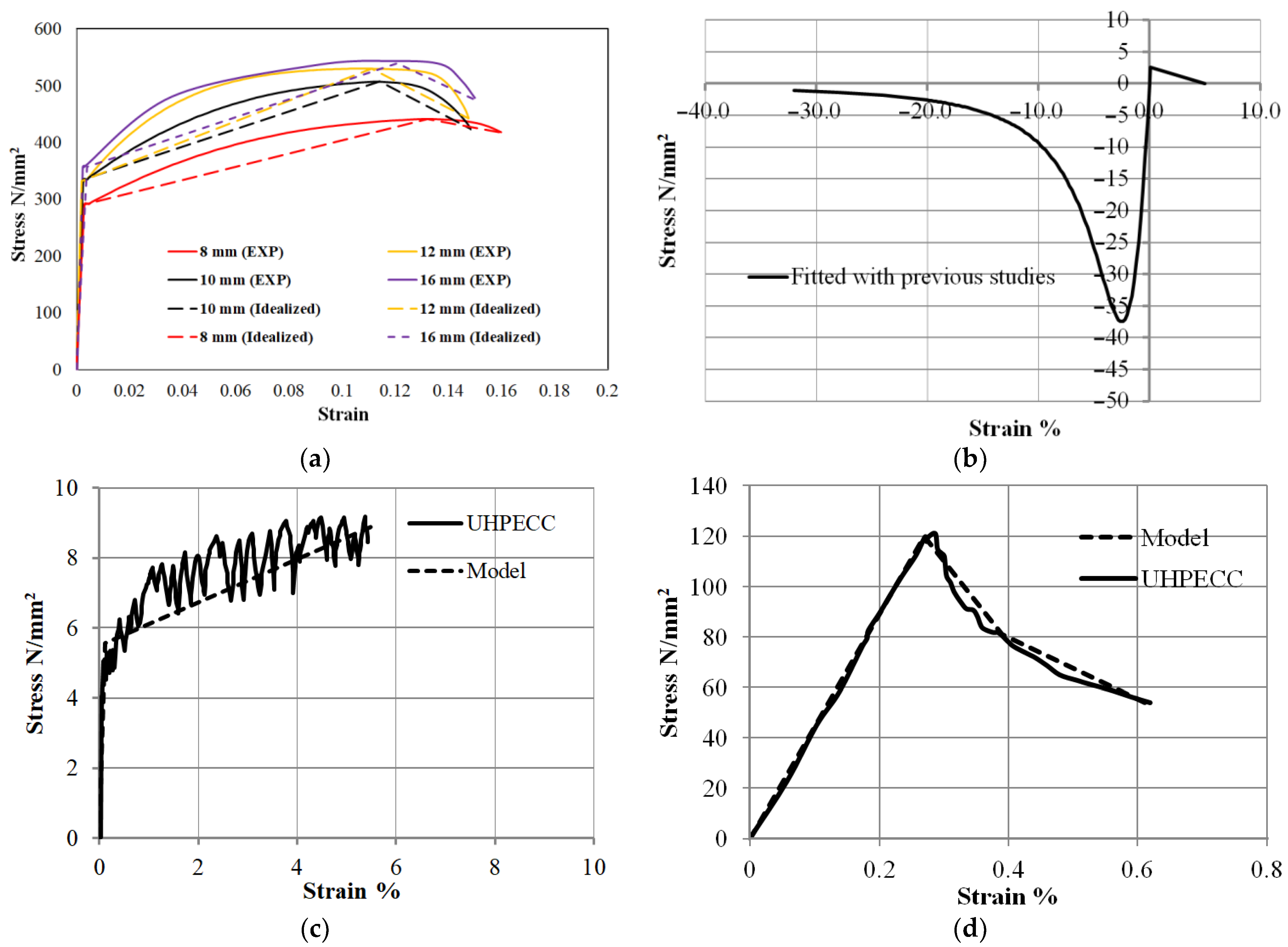

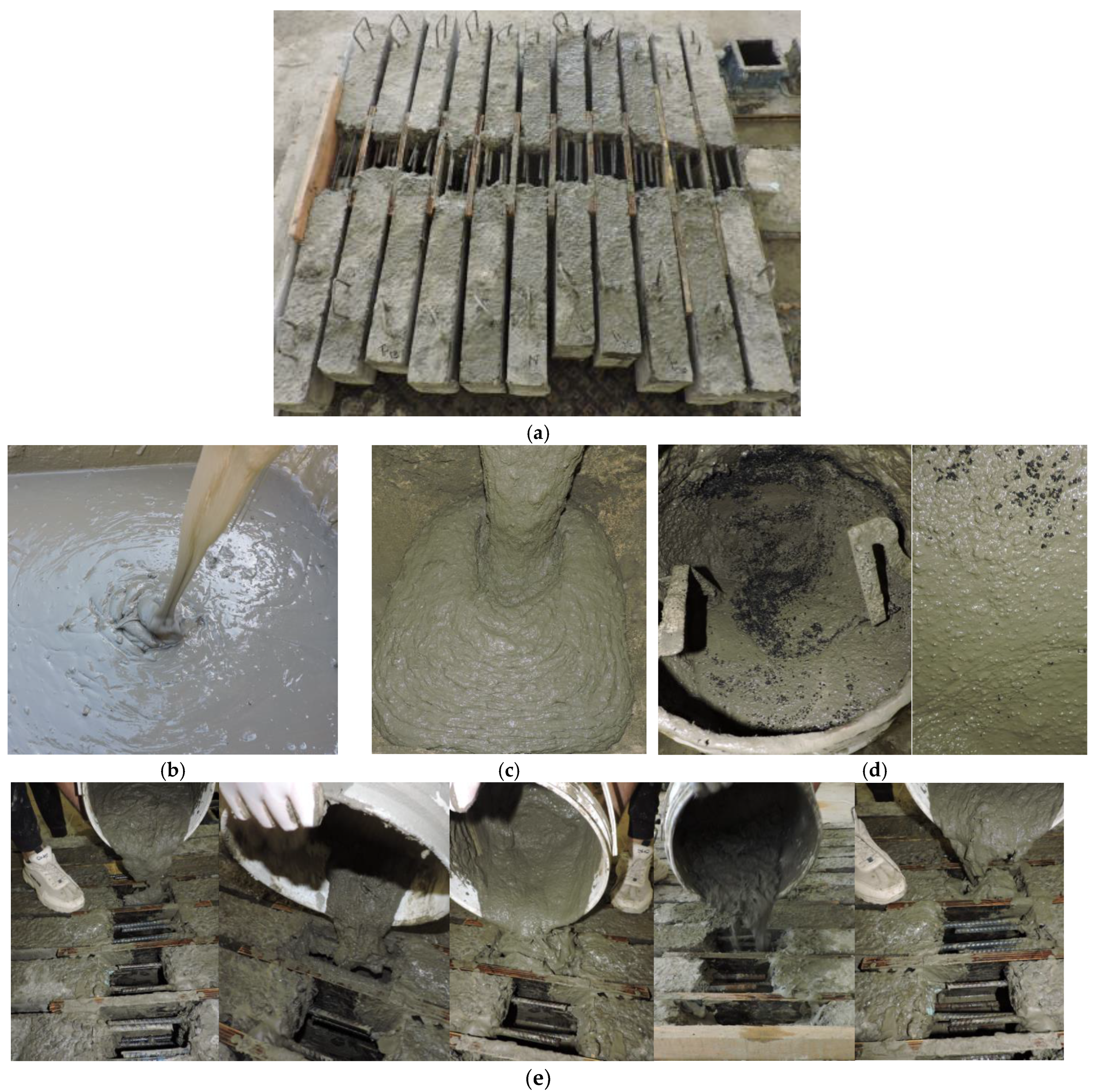
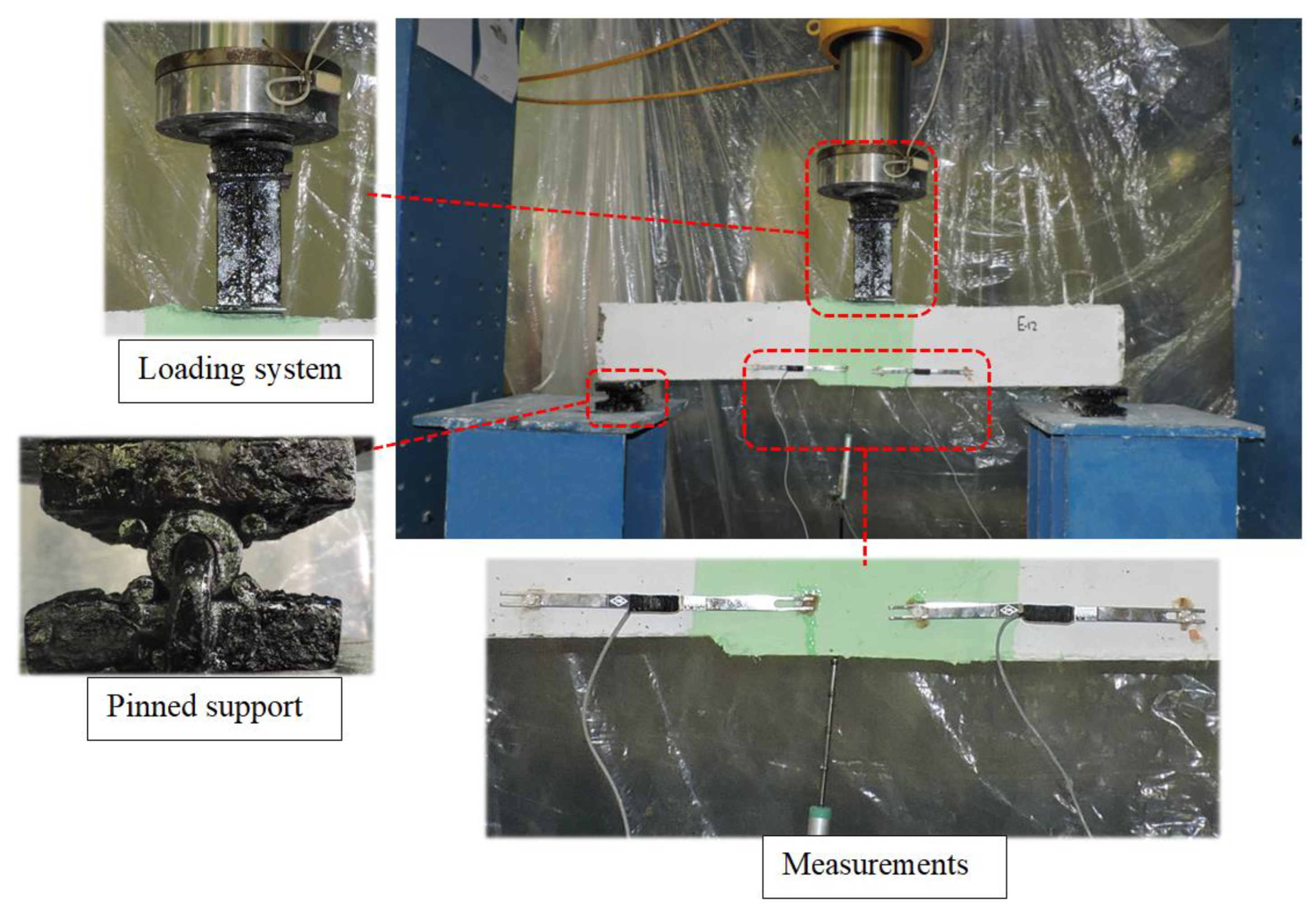
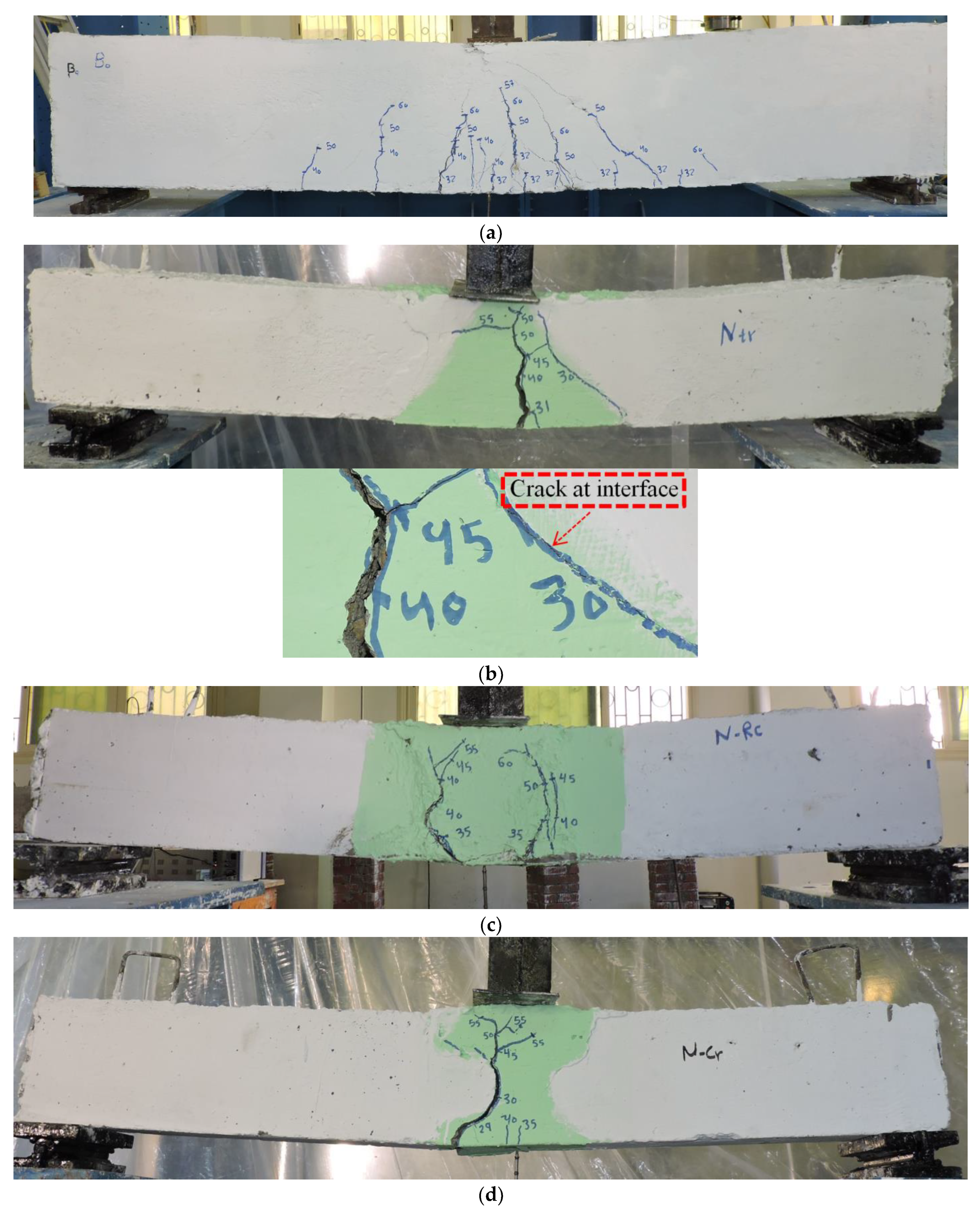
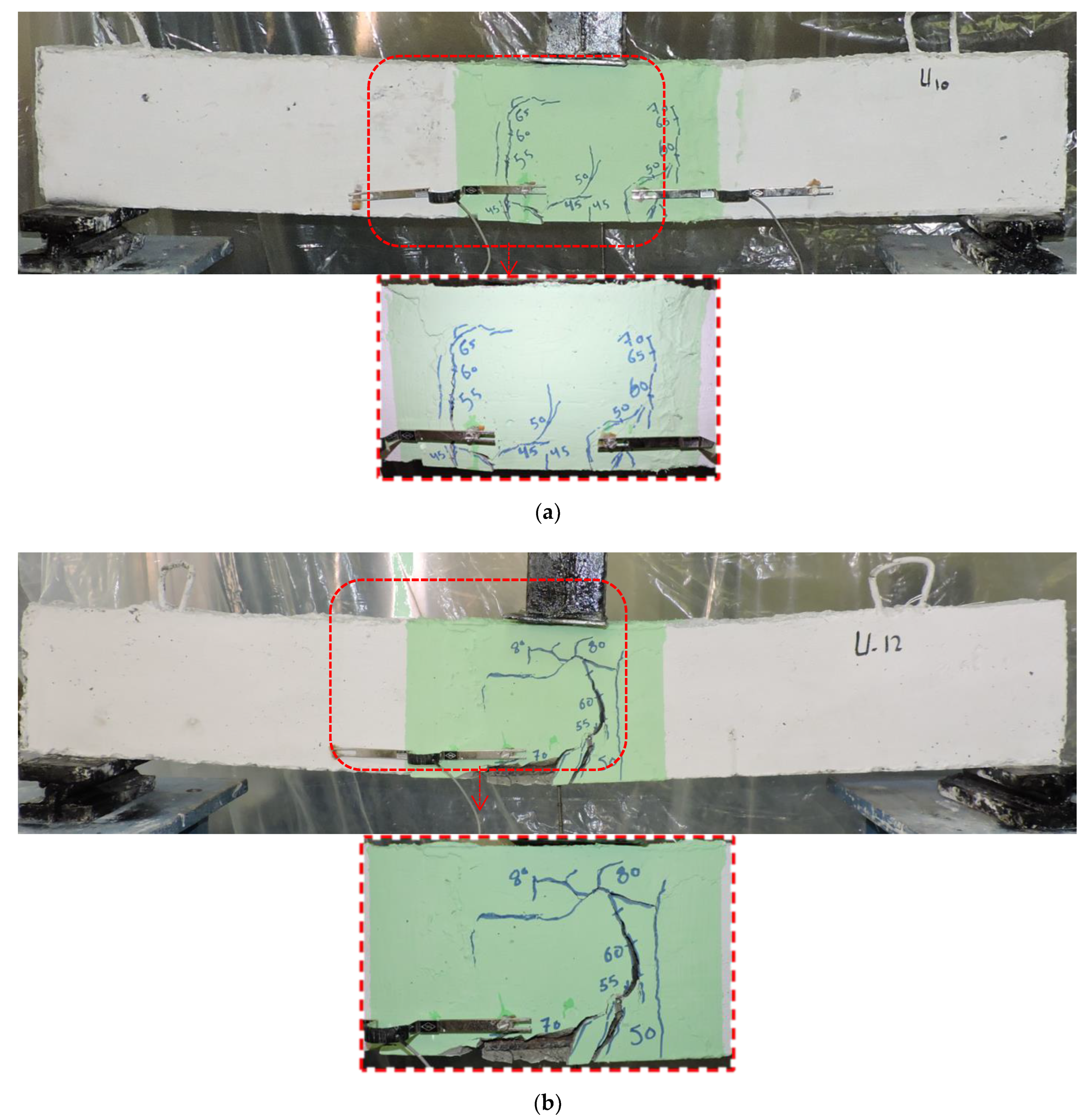

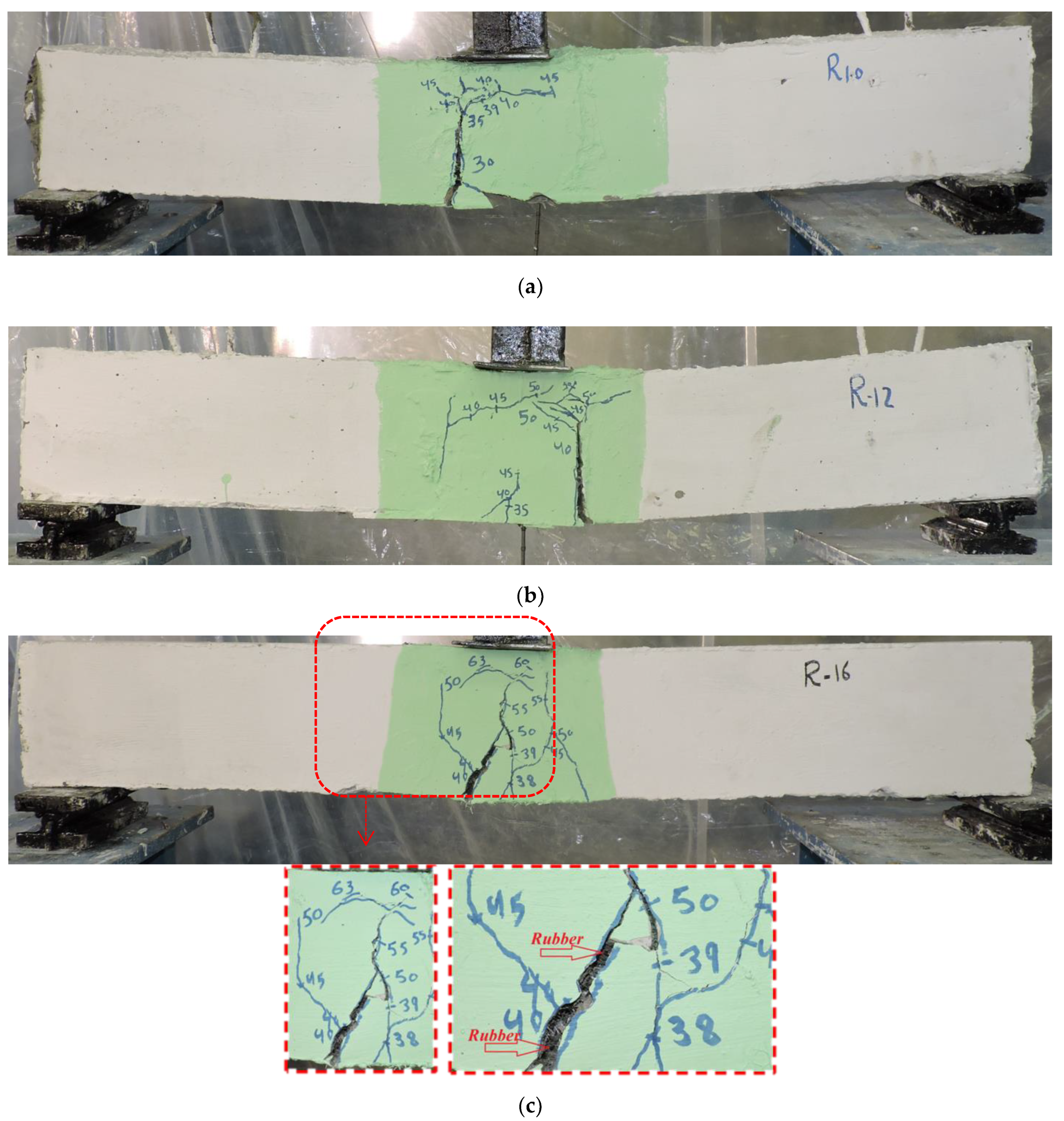
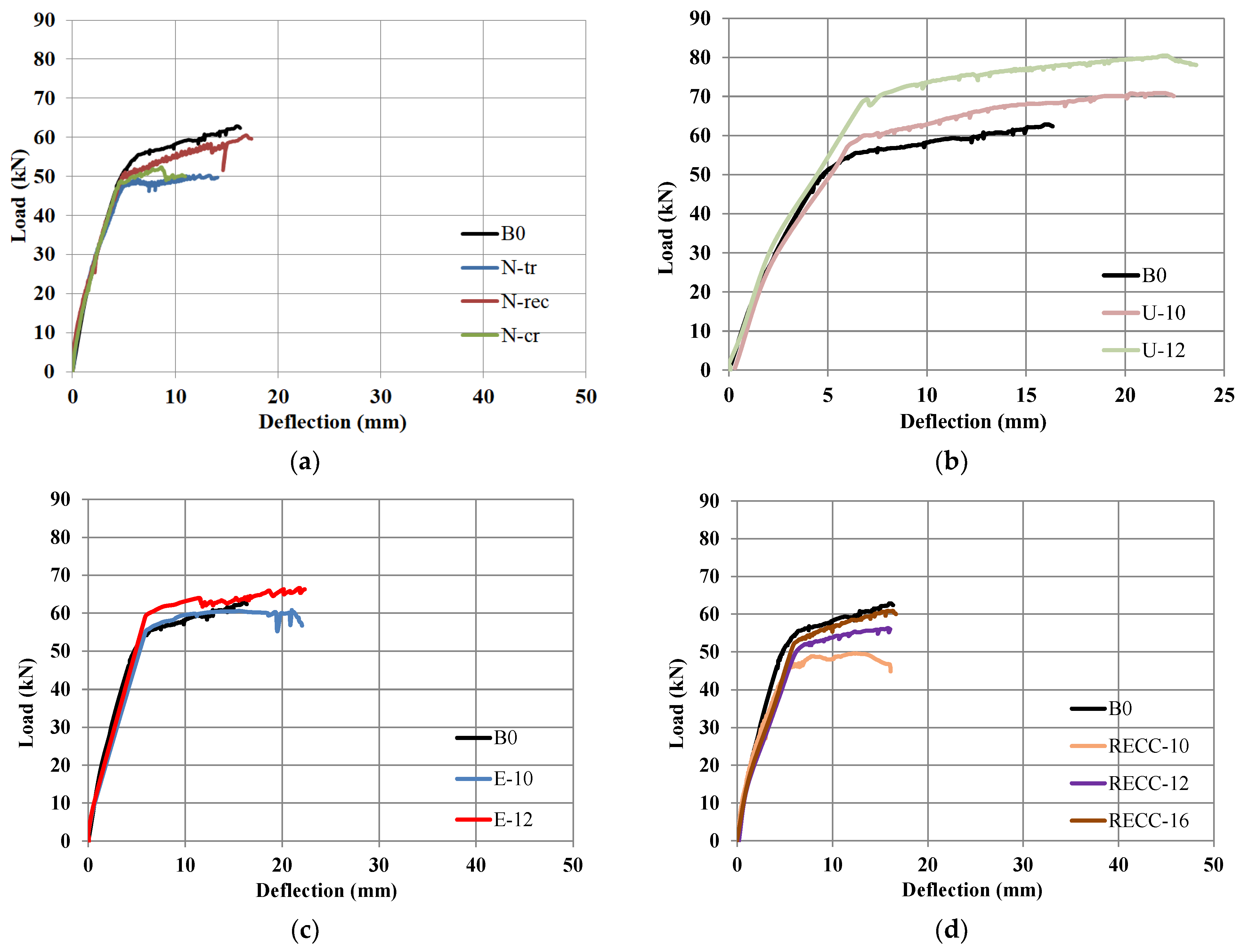
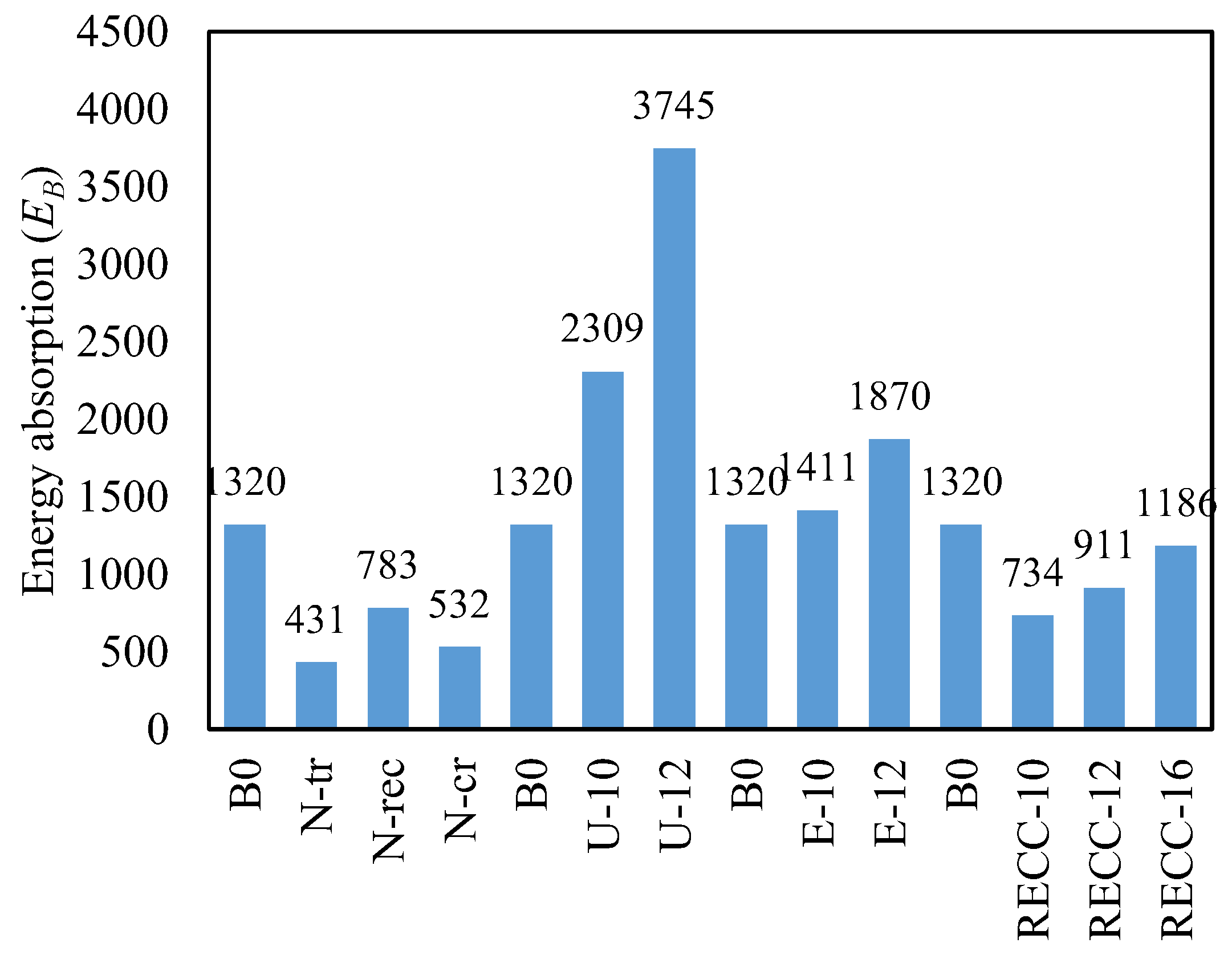
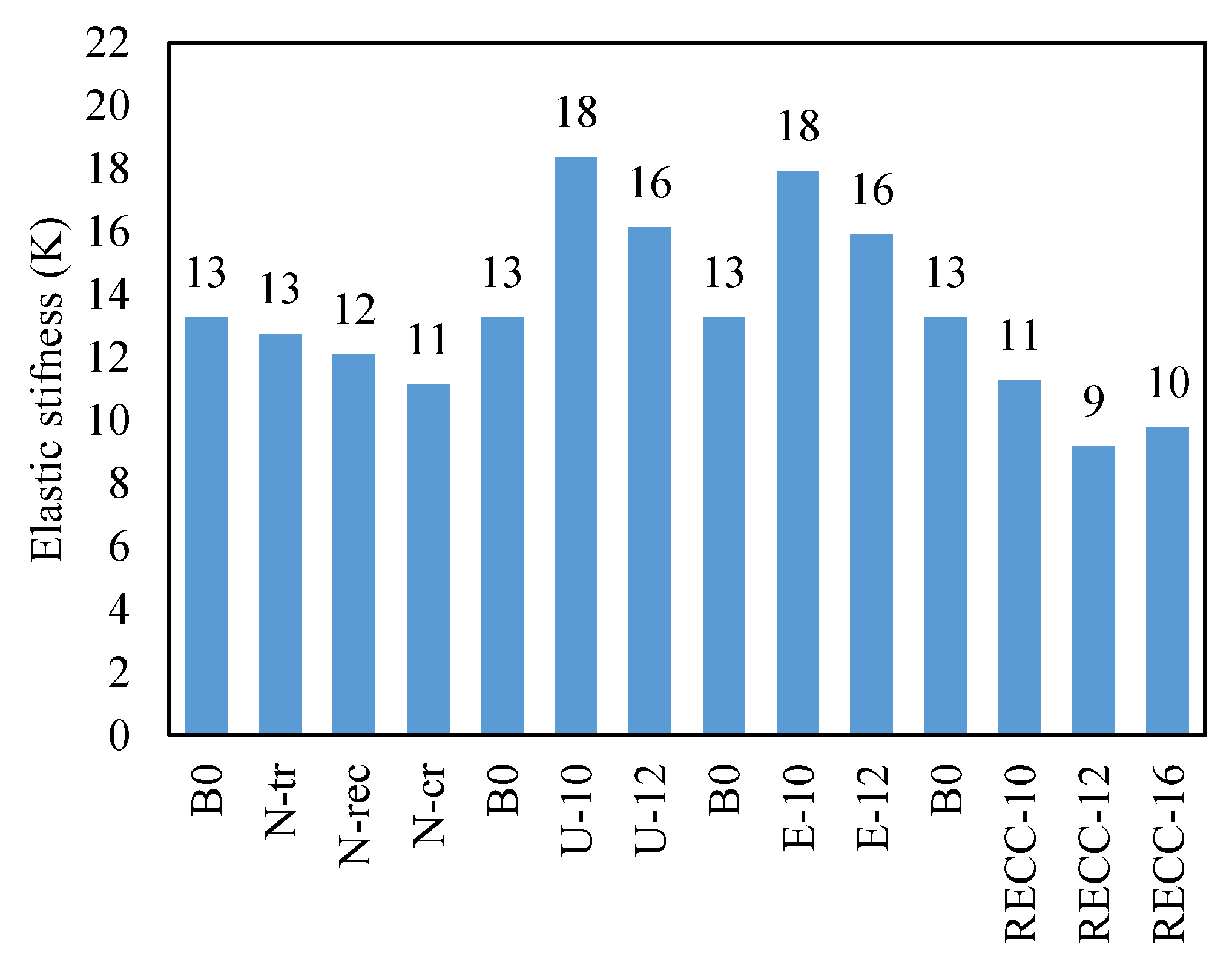


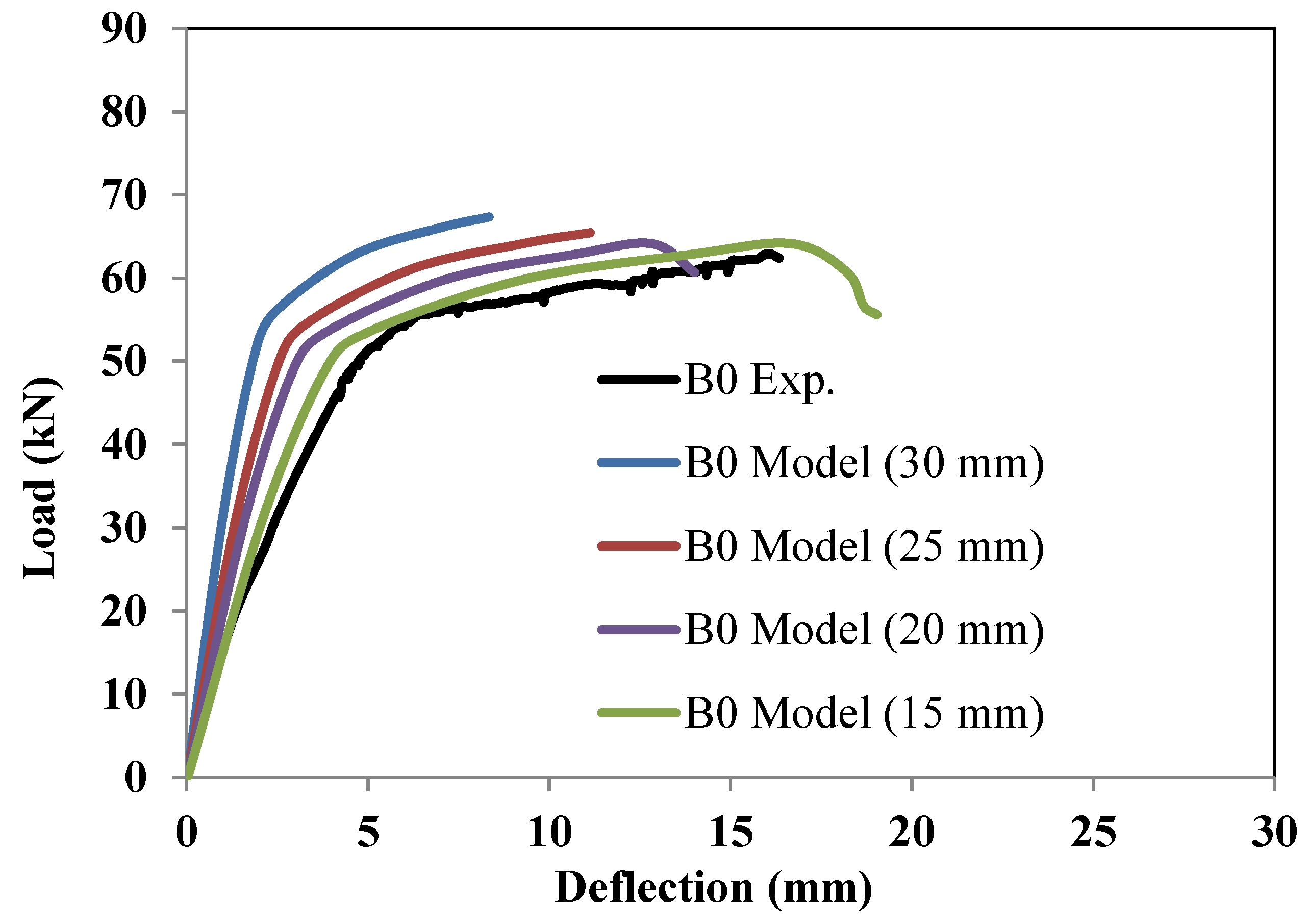
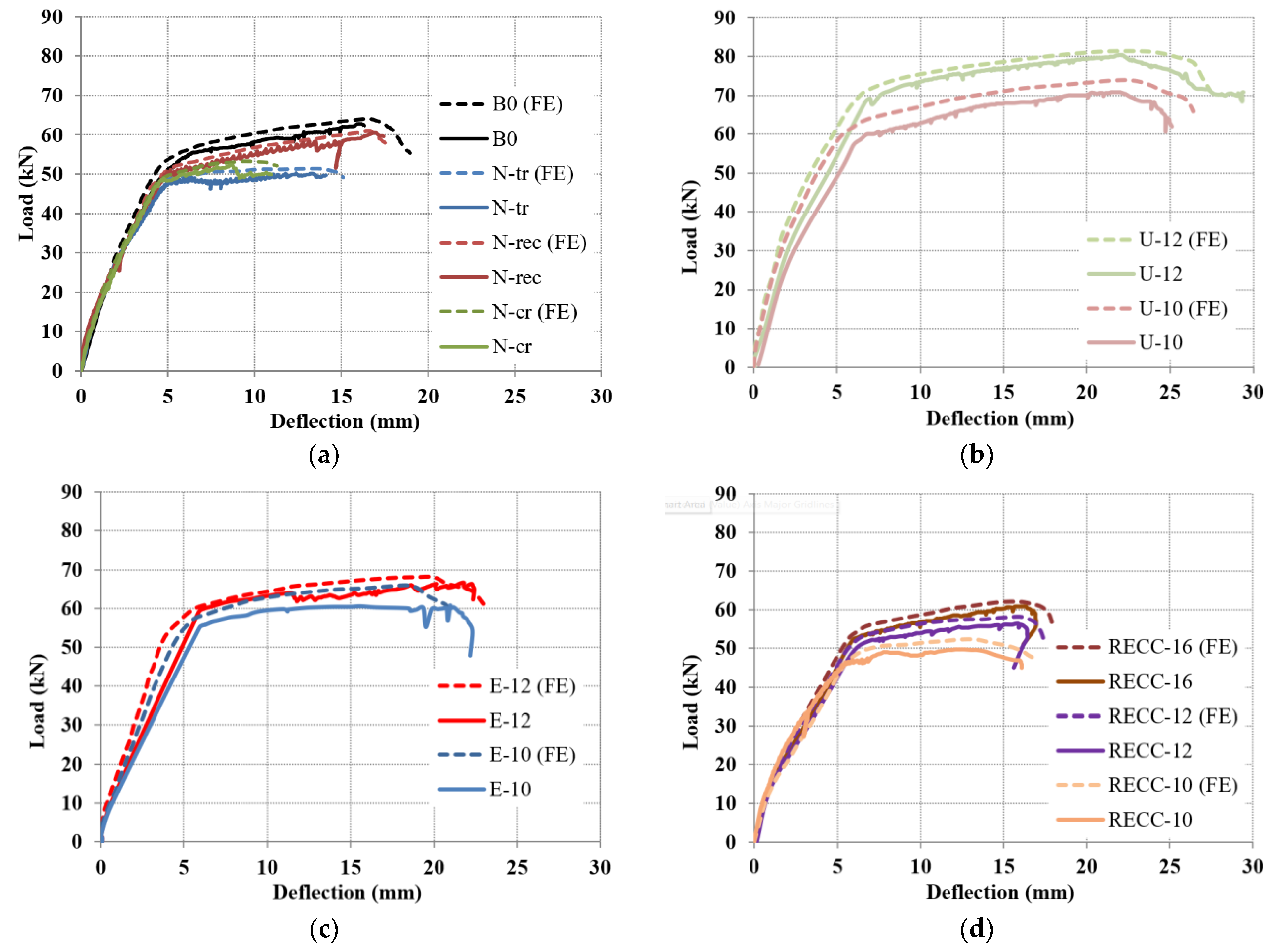

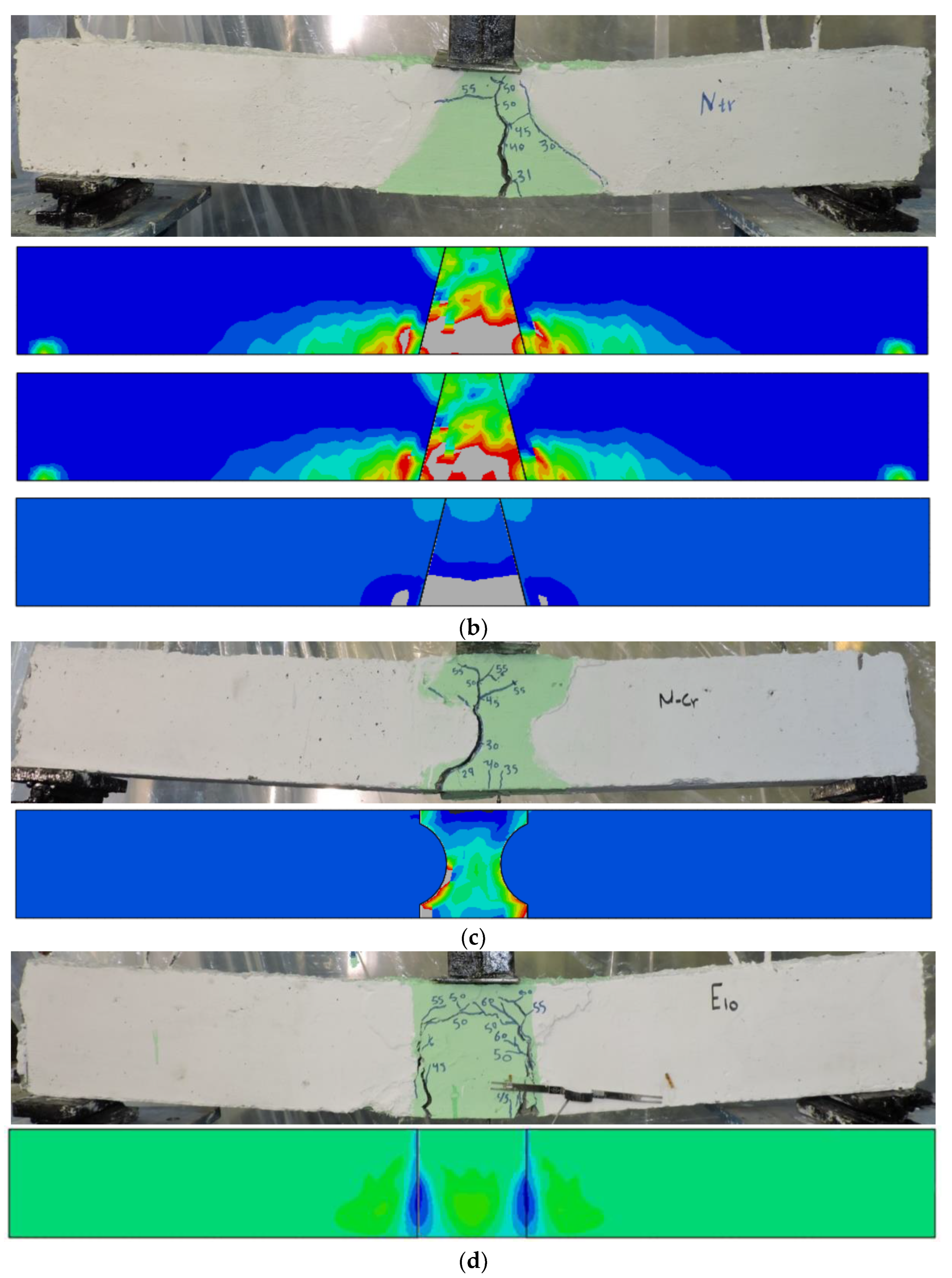

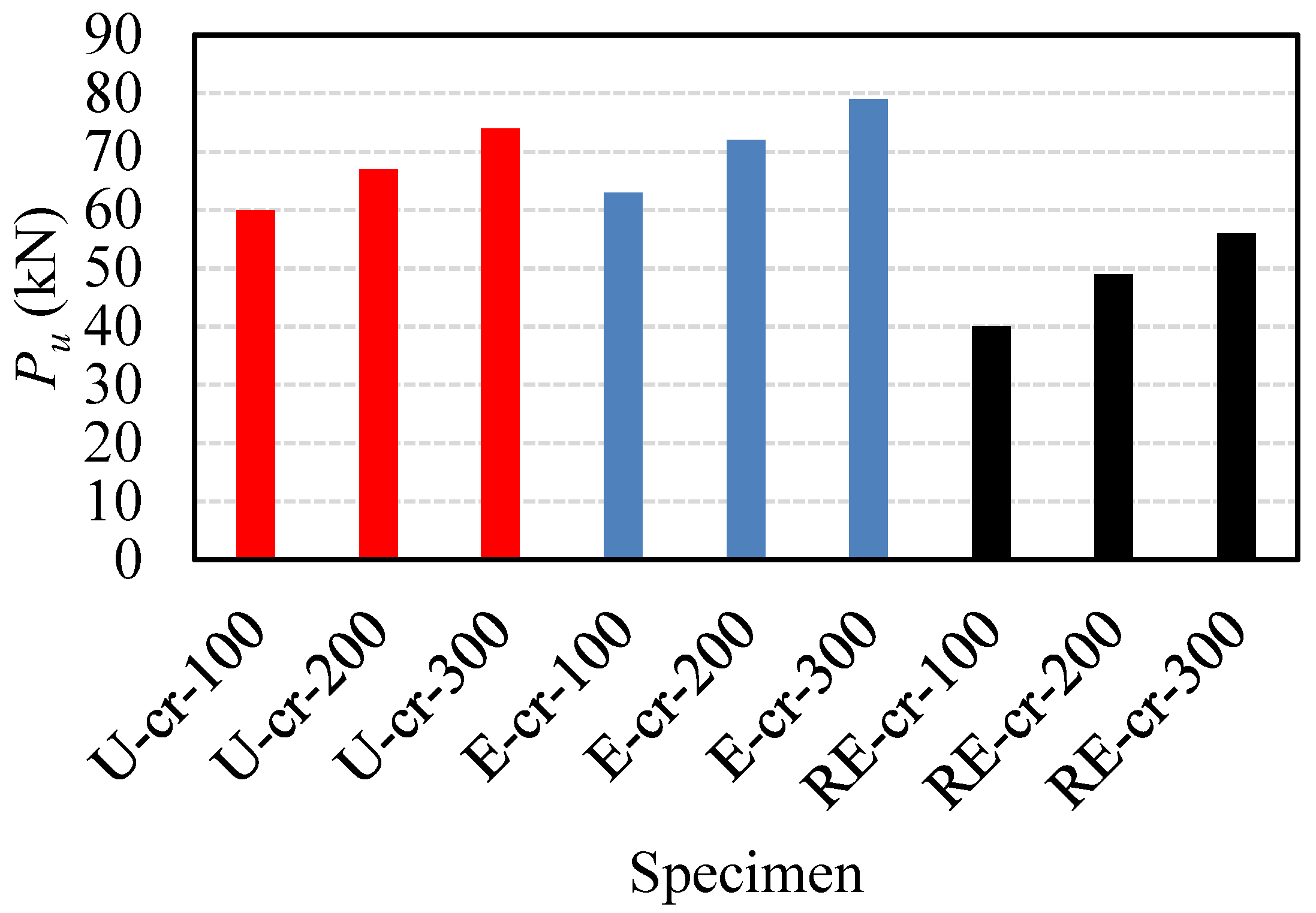
| Group | Beam ID | Details | Concrete Used at the Construction Joint | Type of Joint Form | Bar Diameter (D) (mm) | Lc | Length Value (mm) |
|---|---|---|---|---|---|---|---|
| G-N | B0 | Model A | -------- | -------- | -------- | -------- | -------- |
| N-tr | Model B | NC | Triangular | 10 | 20D | 200 | |
| N-rec | Model C | NC | Rectangular | 10 | 20D | 200 | |
| N-cr | Model D | NC | Semi-circle | 10 | 20D | 200 | |
| G-U | B0 | Model A | -------- | -------- | -------- | -------- | -------- |
| U-10 | Model C | UHPECC | Rectangular | 10 | 20D | 200 | |
| U-12 | Model C | UHPECC | Rectangular | 12 | 16D | 200 | |
| G-E | B0 | Model A | -------- | -------- | -------- | -------- | -------- |
| E-10 | Model C | ECC | Rectangular | 10 | 20D | 200 | |
| E-12 | Model C | ECC | Rectangular | 12 | 16D | 200 | |
| G-RE | B0 | Model A | -------- | -------- | -------- | -------- | -------- |
| RECC-10 | Model C | RECC | Rectangular | 10 | 20D | 200 | |
| RECC-12 | Model C | RECC | Rectangular | 12 | 16D | 200 | |
| RECC-16 | Model C | RECC | Rectangular | 16 | 12D | 200 |
| Steel Element | Position | Yield Stage | Ultimate Stage | E (GPa) | Poisson’s Ratio | ||
|---|---|---|---|---|---|---|---|
| σy (MPa) | εy(%) | σu (MPa) | εu(%) | ||||
| 8 mm | Shear | 291 | 0.154 | 443 | 13.21 | 188 | 0.30 |
| 10 mm | Flexural or compression | 334 | 0.171 | 507 | 11.42 | 195 | 0.30 |
| 12 mm | Flexural | 332 | 0.168 | 530 | 11.11 | 197 | 0.30 |
| 16 mm | Flexural | 358 | 0.196 | 544 | 13.13 | 197 | 0.3 |
| Concrete | Cement (kg/m3) | F.Agg (kg/m3) | C.Agg. (kg/m3) | F.A. (kg/m3) | S.F (kg/m3) | Crumb Rubber (kg/m3) | W/b | PP (kg/m3) | HRWR (kg/m3) | fc` (N/mm2) | ft (N/mm2) |
|---|---|---|---|---|---|---|---|---|---|---|---|
| NC | 349 | 697 | 1151 | --- | --- | --- | 0.42 | --- | --- | 33 | 2.98 |
| UHPECC | 800 | 500 | --- | 750 | 150 | --- | 0.22 | 19 | 40 (S.P) | 129 | 11.85 |
| ECC | 558 | 436 | --- | 665 | --- | --- | 0.23 | 20 | 15 | 52 | 4.43 |
| RECC | 556 | 650 | --- | 660 | --- | 50 | 0.25 | 20 | 14.5 | 42 | 3.82 |
| Group | Specimen | Cracking Stage | Ultimate Stage | Elastic Stiffness | Energy Absorption | ||||||
|---|---|---|---|---|---|---|---|---|---|---|---|
| ID | Pcr | PcrB/PcrB0 | Δcr | Pu | PuB/PuB0 | ΔPu | K (kN/mm) | KB/KB0 | EB (kNmm2) | EB/EB0 | |
| (kN) | (mm) | (kN) | (mm) | ||||||||
| G-N | B0 | 32 | 1.00 | 2.41 | 62 | 1.00 | 16.26 | 13.28 | 1.00 | 1320.24 | 1.00 |
| N-tr | 31 | 0.97 | 2.43 | 50 | 0.81 | 12.40 | 12.76 | 0.96 | 430.92 | 0.33 | |
| N-rec | 35 | 1.09 | 2.89 | 60 | 0.97 | 17.10 | 12.11 | 0.91 | 783.28 | 0.59 | |
| N-cr | 29 | 0.91 | 2.6 | 52 | 0.84 | 9.76 | 11.15 | 0.84 | 531.71 | 0.40 | |
| G-U | B0 | 32 | 1.00 | 2.41 | 62 | 0.92 | 16.26 | 13.28 | 1.00 | 1320.24 | 1.00 |
| U-10 | 45 | 1.41 | 2.45 | 70 | 1.13 | 18.94 | 18.37 | 1.38 | 2308.56 | 1.75 | |
| U-12 | 50 | 1.56 | 3.1 | 80 | 1.29 | 21.38 | 16.13 | 1.21 | 3745.48 | 2.84 | |
| G-E | B0 | 32 | 1.00 | 2.41 | 62 | 0.92 | 16.26 | 13.28 | 1.00 | 1320.24 | 1.00 |
| E-10 | 45 | 1.41 | 2.51 | 60 | 0.97 | 15.60 | 17.93 | 1.35 | 1410.52 | 1.07 | |
| E-12 | 39 | 1.22 | 2.45 | 65 | 1.05 | 21.81 | 15.92 | 1.20 | 1870.13 | 1.42 | |
| G-RE | B0 | 32 | 1.00 | 2.41 | 62 | 0.92 | 16.26 | 13.28 | 1.00 | 1320.24 | 1.00 |
| RECC-10 | 30 | 0.94 | 2.66 | 45 | 0.73 | 5.83 | 11.28 | 0.85 | 733.79 | 0.56 | |
| RECC-12 | 35 | 1.09 | 3.81 | 55 | 0.89 | 14.44 | 9.19 | 0.69 | 910.69 | 0.69 | |
| RECC-16 | 38 | 1.19 | 3.88 | 63 | 1.02 | 16.35 | 9.79 | 0.74 | 1185.75 | 0.90 | |
| Group | Specimen | Cracking | Ultimate | ||||||||||
|---|---|---|---|---|---|---|---|---|---|---|---|---|---|
(kN) | (kN) | (mm) | (mm) | (kN) | (kN) | (mm) | (mm) | ||||||
| GN | B0 | 35 | 32 | 1.094 | 2.75 | 2.41 | 1.141 | 64 | 62 | 1.032 | 16.87 | 16.26 | 1.038 |
| N-tr | 33 | 31 | 1.065 | 2.73 | 2.43 | 1.123 | 51 | 50 | 1.020 | 12.79 | 12.40 | 1.031 | |
| N-rec | 33 | 35 | 0.943 | 2.62 | 2.89 | 0.907 | 62 | 60 | 1.033 | 16.64 | 17.10 | 0.973 | |
| N-cr | 34 | 29 | 1.172 | 2.76 | 2.6 | 1.062 | 53 | 52 | 1.019 | 9.35 | 9.76 | 0.958 | |
| G-U | B0 | 35 | 32 | 1.094 | 2.75 | 2.41 | 1.141 | 64 | 62 | 1.032 | 16.87 | 16.26 | 1.038 |
| U-10 | 50 | 45 | 1.111 | 3.64 | 2.45 | 1.486 | 74 | 70 | 1.057 | 21.52 | 18.94 | 1.136 | |
| U-12 | 52 | 50 | 1.040 | 3.87 | 3.1 | 1.248 | 82 | 80 | 1.025 | 23.14 | 21.35 | 1.084 | |
| G-E | B0 | 35 | 32 | 1.094 | 2.75 | 2.41 | 1.141 | 64 | 62 | 1.032 | 16.87 | 16.26 | 1.038 |
| E-10 | 43 | 45 | 0.956 | 3.11 | 2.51 | 1.239 | 66 | 60 | 1.100 | 18.41 | 15.60 | 1.180 | |
| E-12 | 44 | 39 | 1.128 | 3.13 | 2.45 | 1.278 | 68 | 65 | 1.046 | 18.93 | 21.81 | 0.868 | |
| G-RECC | B0 | 35 | 32 | 1.094 | 2.75 | 2.41 | 1.141 | 64 | 62 | 1.032 | 16.87 | 16.26 | 1.038 |
| RECC-10 | 32 | 30 | 1.067 | 3.42 | 2.66 | 1.286 | 52 | 45 | 1.156 | 12.43 | 11.28 | 1.102 | |
| RECC-12 | 34 | 35 | 0.971 | 3.31 | 3.81 | 0.869 | 58 | 55 | 1.055 | 15.92 | 9.19 | 1.732 | |
| RECC-16 | 34 | 38 | 0.895 | 3.34 | 3.88 | 0.861 | 62 | 63 | 0.984 | 15.94 | 9.79 | 1.628 | |
| Mean | 1.052 | 1.137 | 1.045 | 1.132 | |||||||||
| Standard deviation | 0.077 | 0.168 | 0.039 | 0.237 | |||||||||
| Coefficient of variation | 0.074 | 0.147 | 0.038 | 0.209 | |||||||||
| Group | Beam ID | Details | Concrete Used at the Construction Joint | Type of Joint Form | Bar Diameter (D) (mm) | Lc | Length Value (mm) |
|---|---|---|---|---|---|---|---|
| G-U | U-tr | Model B | UHPECC | Triangular | 10 | 20D | 200 |
| U-rec | Model C | UHPECC | Rectangular | 10 | 20D | 200 | |
| U-cr | Model D | UHPECC | Semi-circle | 10 | 20D | 200 | |
| G-E | E-tr | Model B | ECC | Triangular | 10 | 20D | 200 |
| E-rec | Model C | ECC | Rectangular | 10 | 20D | 200 | |
| E-cr | Model D | ECC | Semi-circle | 10 | 20D | 200 | |
| G-RE | R-tr | Model B | RECC | Triangular | 10 | 20D | 200 |
| R-rec | Model C | RECC | Rectangular | 10 | 20D | 200 | |
| R-cr | Model D | RECC | Semi-circle | 10 | 20D | 200 | |
| G-U-cr | U-cr-100 | Model D | UHPECC | Semi-circle | 10 | 10D | 100 |
| U-cr-200 | Model D | UHPECC | Semi-circle | 10 | 20D | 200 | |
| U-cr-300 | Model D | UHPECC | Semi-circle | 10 | 30D | 300 | |
| G-E-cr | E-cr-100 | Model D | ECC | Semi-circle | 10 | 10D | 100 |
| E-cr-200 | Model D | ECC | Semi-circle | 10 | 20D | 200 | |
| E-cr-300 | Model D | ECC | Semi-circle | 10 | 30D | 300 | |
| G-RE-cr | R-cr-100 | Model D | RECC | Semi-circle | 10 | 10D | 100 |
| R-cr-200 | Model D | RECC | Semi-circle | 10 | 20D | 200 | |
| R-cr-300 | Model D | RECC | Semi-circle | 10 | 30D | 300 |
Disclaimer/Publisher’s Note: The statements, opinions and data contained in all publications are solely those of the individual author(s) and contributor(s) and not of MDPI and/or the editor(s). MDPI and/or the editor(s) disclaim responsibility for any injury to people or property resulting from any ideas, methods, instructions or products referred to in the content. |
© 2024 by the authors. Licensee MDPI, Basel, Switzerland. This article is an open access article distributed under the terms and conditions of the Creative Commons Attribution (CC BY) license (https://creativecommons.org/licenses/by/4.0/).
Share and Cite
Hamoda, A.; Emara, M.; Ahmed, M.; Abadel, A.A.; Patel, V.I. Flexural Behavior of Precast Rectangular Reinforced Concrete Beams with Intermediate Connection Filled with High-Performance Concrete. Buildings 2024, 14, 2823. https://doi.org/10.3390/buildings14092823
Hamoda A, Emara M, Ahmed M, Abadel AA, Patel VI. Flexural Behavior of Precast Rectangular Reinforced Concrete Beams with Intermediate Connection Filled with High-Performance Concrete. Buildings. 2024; 14(9):2823. https://doi.org/10.3390/buildings14092823
Chicago/Turabian StyleHamoda, Ahmed, Mohamed Emara, Mizan Ahmed, Aref A. Abadel, and Vipulkumar Ishvarbhai Patel. 2024. "Flexural Behavior of Precast Rectangular Reinforced Concrete Beams with Intermediate Connection Filled with High-Performance Concrete" Buildings 14, no. 9: 2823. https://doi.org/10.3390/buildings14092823







